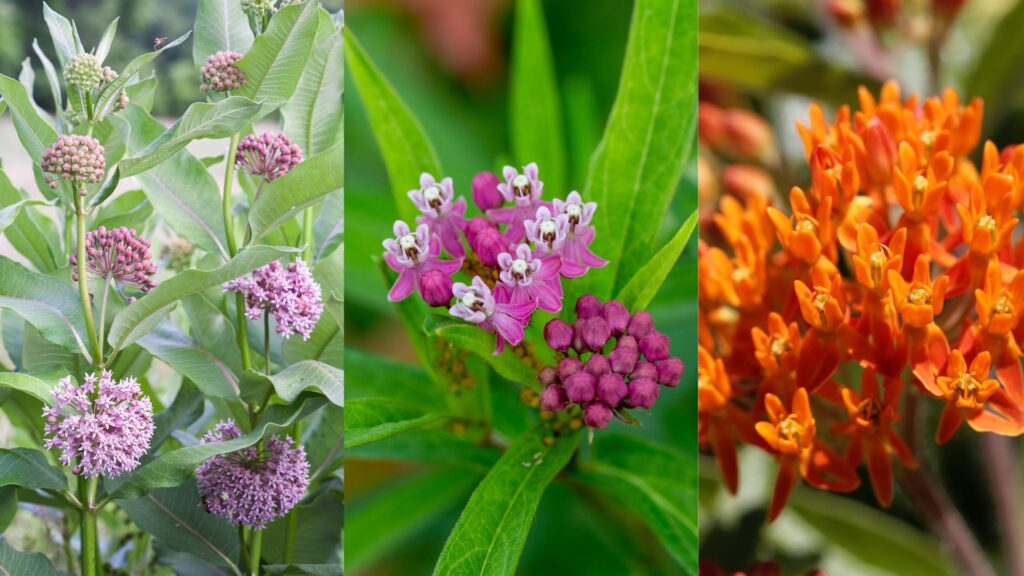All About Milkweed
By Mary Gannon, NCSL Volunteer
A wonderfully fragrant perennial native plant, milkweed is the one and only host plant that supports monarch butterflies. Monarchs depend upon milkweed now—more than ever—as monarch populations have declined 80% in recent years. It’s only natural that milkweed should become one of the cornerstone plants in native pollinator gardens.
Types of milkweed

Pictured here from left to right: Common milkweed, swamp milkweed, and butterfly milkweed varieties.
Over 100 milkweed species are native to the Americas and it’s important to find the ones native to Northeast Ohio. All milkweeds contain toxins that can harm grazing animals and humans when consumed. However, with a general understanding, milkweed can safely be incorporated into any yard.
Common milkweed (Asclepias syriaca) has long, oval leaves and grows to 4-5 feet tall. Its clusters of tiny pink flowers emit a heady scent that rivals any flower! Common milkweed spreads with gusto through underground rhizomes as well as its seeds. It is best to give it lots of room to spread…otherwise, you’ll be pinching and cutting a lot. Milkweed is named for the milky substance that oozes from its stems and leaves.
Swamp milkweed/rose milkweed (Asclepias incarnata) is a more sedate version of the common type as far as scent (softer and less bodacious) and spread (it stays where it’s planted). With mauve pink floral clusters and leaves that are narrow and pointed at the tips, the plant itself rises to 4’ to 5’ tall.
Butterfly weed (Asclepias tuberosa) is the bright, orange-flowered cousin that typically grows 1-2 feet tall. The usual bloom time is from June to August. This species does not spread by rhizomes. It likes very well-drained soil and may be better suited if you have a small space.
View Reference Sheet for Milkweed 4 Monarchs Sale
Note that tropical milkweed is best to be avoided entirely as it is not native to our region.
Toxicity explained
“Common milkweed is Nature’s mega food market for insects,” says the U.S. Forest Service. Hundreds of butterflies and bugs dine on its leaves and flowers. On the other hand, milkweed contains a toxic milky sap that deters many animals and insects from eating it at all! So what gives?!
For some lucky insects, evolution allows them to eat and store those toxins in their own bodies so that they too become toxic to their prey. Monarchs are an example of this. Monarchs find nectar in the flowers, lay their eggs on the leaves, then the caterpillar feeds on the leaves before becoming a butterfly.
Many other brightly-colored insects have a similar relationship with milkweed. For instance, orange and black milkweed bugs gather in large clusters on the seed pods. While our first reaction may be to get rid of them, they play a role in our ecosystem and do no real harm to the milkweed plant.
Here are some insects that visit milkweed for pollen: eastern swallowtail butterflies, skippers, bumble bees, hummingbird moths, painted lady butterflies, and yellow-faced bees.
How to grow milkweed from seed
- When and where to plant: during the fall season, sow the seeds in a sunny location (6-8 hours of sun). Common milkweed needs a lot of room to expand. For swamp milkweed, a consistently moist location is best. And for butterfly milkweed, excellent drainage is beneficial.
- How to plant seeds: place them in weed-free soil that’s smooth and without large clumps. Press the seeds lightly into the soil (don’t cover them) to give them good contact with the soil. In the spring, water the area consistently until the seedlings are established.
- How to give them room to grow: you should start thinning out your seedlings till they are about 1’ to 2’ apart. First-year seedlings may only reach 10” in height. They will reach mature height and flower by the third year (maybe even the second year).
- How to harvest seeds: during mid-summer, milkweed starts forming green, elongated tear-shaped seed pods. As they mature, the pods dry and turn brown. Now is the time to gather the seeds, because soon enough the pods will split open and the seeds will float away with the wind. (Or you can choose to tie up each pod with string so they can’t open till you’re ready to deal with them.)
- How to store and share your seeds: make sure you separate the seeds from the floss, dry the seeds thoroughly, put them in an envelope and label and date it. (A fun, kid-friendly way to separate the seeds is to put the flossy seeds in a paper bag with a couple of pennies. Close it up and shake. Next, cut a small hole in the bottom of the bag, the seeds should fall out, leaving the floss behind.) If you wish to store your seeds for next year, you’ll need to place your seed packets in a refrigerator or freezer for several weeks (called cold stratification)…a process that mimics nature.
Including milkweed in your garden
- A rain garden is a natural setting for swamp milkweed. Add other moisture-loving native plants like cardinal flower, iris, marsh marigold and joe pye weed.
- Make a tall wildflower meadow as a privacy screen. Start with common milkweed. Add blue vervain, prairie dock, cup plant and iron weed.
- Plant natives with succession in mind: early flowering wild blue indigo and meadow sage, followed by black-eyed Susan, Liatris and milkweed, and continue into autumn with asters and goldenrod.
Join the milkweed-for-monarchs movement
- Join a pollinator pathway group
- Share your enthusiasm with neighbors
- Share your native garden on social media and tag @shakerlakes
- Follow the monarch migration route
- Educate yourself and others about the plight of the monarch
